Effects of No-Tillage on Field Microclimate and Yield of Winter Wheat
Abstract
1. Introduction
2. Materials and Methods
2.1. Overview of the Experimental Site
2.2. Experimental Materials
2.2.1. Equipment for No-Till and Conventional Wheat Sowing and Fertilization
2.2.2. Environmental Monitoring System
2.3. Experimental Methods
2.3.1. Experimental Design
2.3.2. Data Collection and Measurement Methods
2.4. Data Analysis
3. Results
3.1. Air Temperature at 20 cm and 100 cm Above the Ground During the Wheat Grain-Filling Stage (69–89)
3.2. Relative Humidity of the Air at 20 cm and 100 cm Above the Ground During the Wheat Grain-Filling Stage (69–89)
3.3. Soil Moisture Content at 20 cm Below the Ground at the Early Stage of Wheat Grain-Filling (69–75)
3.4. Moisture Content of Wheat Plants and Spike Moisture Content Before Harvest (86)
3.5. Wheat Yield and Yield Components
4. Discussion
4.1. Effects of Different Tillage Methods on Microclimate in Wheat Fields
4.2. Effects of Different Tillage Methods on Wheat Yield
5. Conclusions
Author Contributions
Funding
Data Availability Statement
Conflicts of Interest
References
- Li, Q.Q.; Dong, B.D.; Qiao, Y.Z.; Liu, M.Y.; Zhang, J.W. Root growth, available soil moisture, and moisture-use efficiency of winter wheat under different irrigation regimes applied at different growth stages in North China. Agric. Water Manag. 2010, 97, 1676–1682. [Google Scholar] [CrossRef]
- Wang, Q.M.; Hu, F.L.; Chai, Q. Effect of conservation tillage on natural resources utilization efficiency and sustainability of integrated wheat-maize intercropping system. Chin. J. Eco-Agric. 2019, 27, 1344–1353, (In Chinese with English abstract). [Google Scholar] [CrossRef]
- Bottinelli, N.; Angers, D.A.; Hallaire, V.; Michot, D.; Guillou, C.L. Tillage and fertilization practices affect soil aggregate stability in a humic cambisol of Northwest France. Soil Tillage Res. 2017, 170, 14–17. [Google Scholar] [CrossRef]
- Wang, X.B.; Wu, H.J.; Dai, K.; Zhang, D.C.; Feng, Z.H.; Zhao, Q.S.; Wu, X.P.; Jin, K.; Cai, D.X.; Oenema, O.; et al. Tillage and crop residue effects on rainfed wheat and maize production in northern China. Field Crop Res. 2012, 132, 106–116. [Google Scholar] [CrossRef]
- Ren, Z.J.; Han, X.J.; Feng, H.X.; Wang, L.F.; Ma, G.; Li, J.H.; Lv, J.J.; Tian, W.Z.; He, X.H.; Zhao, Y.N.; et al. Long-term conservation tillage improves soil stoichiometry balance and crop productivity based on a 17-year experiment in a semi-arid area of northern China. Sci. Total Environ. 2024, 908, 168283. [Google Scholar] [CrossRef]
- Su, Z.Y.; Zhang, J.S.; Wu, W.L.; Cai, D.X.; Lv, J.J.; Jiang, G.H.; Huang, J.; Gao, J.; Hartmann, R.; Gabriels, D. Effects of conservation tillage practices on winter wheat water-use efficiency and crop yield on the Loess Plateau, China. Agric. Water Manag. 2007, 87, 307–314. [Google Scholar] [CrossRef]
- Pittelkow, C.M.; Liang, X.Q.; Linquist, B.A.; Van Groenigen, K.J.; Lee, J.; Lundy, M.E.; Van, G.N.; Six, J.; Venterea, R.T.; Van, K.C. Productivity limits and potentials of the principles of conservation agriculture. Nature 2015, 517, 365–368. [Google Scholar] [CrossRef]
- Brouder, S.M.; Gomez-Macpherson, H. The impact of conservation agriculture on smallholder agricultural yields: A scoping review of the evidence. Agric. Ecosyst. Environ. 2014, 187, 11–32. [Google Scholar] [CrossRef]
- Giller, K.E.; Corbeels, M.; Nyamangara, J.; Triomphe, B.; Affholder, F.; Scopel, E.; Tittonell, P. A research agenda to explore the role of conservation agriculture in African smallholder farming systems. Field Crop Res. 2011, 124, 468–472. [Google Scholar] [CrossRef]
- Zhang, H.L.; Lal, R.; Zhao, X.; Xue, J.F.; Chen, F. Opportunities and challenges of soil carbon sequestration by conservation agriculture in China. Adv. Agron. 2014, 124, 1–36. [Google Scholar] [CrossRef]
- Lampurlanés, J.; Plaza-Bonilla, D.; Álvaro-Fuentes, J.; Cantero-Martínez, C. Long-term analysis of soil water conservation and crop yield under different tillage systems in Mediterranean rainfed conditions. Field Crop Res. 2016, 189, 59–67. [Google Scholar] [CrossRef]
- Liu, S.; Zhang, X.Y.; Kravchenko, Y.; Iqbal, M.A. Maize (Zea mays L.) yield and soil properties as affected by no tillage in the black soils of China. Acta Agric. Scand. Sect. B-Soil Plant Sci. 2015, 65, 554–565. [Google Scholar] [CrossRef]
- Schwartz, R.C.; Baumhardt, R.L.; Evett, S.R. Tillage effects on soil water redistribution and bare soil evaporation throughout a season. Soil Tillage Res. 2010, 110, 221–229. [Google Scholar] [CrossRef]
- Feng, F.X.; Huang, G.B.; Yu, A.Z.; Chai, Q.; Tao, M.; Li, J. Effects of different conservation tillage measures on winter wheat water use in Wuwei oasis irrigated area. Chin. J. Appl. Ecol. 2009, 20, 1060–1065, (In Chinese with English abstract). [Google Scholar] [CrossRef]
- Huang, Y.W.; Tao, B.; Zhu, X.C.; Yang, Y.J.; Liang, L.; Wang, L.X.; Pierre-Andre, J.; Tian, H.Q.; Ren, W. Conservation tillage increases corn and soybean water productivity across the Ohio River Basin. Agric. Water Manag. 2021, 254, 106962. [Google Scholar] [CrossRef]
- Parihar, C.M.; Yadav, M.R.; Jat, S.L.; Singh, A.K.; Kumar, B.; Pooniya, V.; Pradhan, S.; Verma, R.K.; Jat, M.L.; Jat, R.K.; et al. Long-term conservation agriculture and intensified cropping systems: Effects on growth, yield, water, and energy-use efficiency of maize in northwestern India. Pedosphere 2018, 28, 952–963. [Google Scholar] [CrossRef]
- Li, L.L.; Huang, G.B.; Qin, S.H.; Yu, A.Z. Effect of conservation tillage on dry matter accumulating and yield of winter wheat in oasis area. Acta Agron. Sin. 2011, 37, 514–520, (In Chinese with English abstract). [Google Scholar] [CrossRef]
- Zhang, X.C.; Pan, X.; Wang, H.L. Research on contrast test of wheat no tillage seeding and deep plowing rotary tillage seeding. J. Chin. Agric. Mech. 2016, 37, 28–31, (In Chinese with English abstract). [Google Scholar] [CrossRef]
- Teng, J.L.; Hou, R.X.; Dungait, J.A.J.; Zhou, G.Y.; Kuzyakov, Y.; Zhang, J.B.; Tian, J.; Cui, Z.L.; Zhang, F.S.; Delgado-Baquerizo, M. Conservation agriculture improves soil health and sustains crop yields after long-term warming. Nat. Commun. 2024, 15, 8785. [Google Scholar] [CrossRef]
- Tian, S.Z.; Ning, T.Y.; Wang, Y.; Liu, Z.; Li, G.; Li, Z.J.; Lal, R. Crop yield and soil carbon responses to tillage method changes in North China. Soil Tillage Res. 2016, 163, 207–213. [Google Scholar] [CrossRef]
- Cambron, T.W.; Deines, J.M.; Lopez, B.; Patel, R.; Liang, S.Z.; Lobell, D.B. Further adoption of conservation tillage can increase maize yields in the western US corn Belt. Environ. Res. Lett. 2024, 19, 054040. [Google Scholar] [CrossRef]
- Mathers, C.; Heitman, J.; Huse, A.; Locke, A.; Osmond, D.; Woodley, A. No-till imparts yield stability and greater cumulative yield under variable weather conditions in the southeastern USA piedmont. Field Crop Res. 2023, 292, 108811. [Google Scholar] [CrossRef]
- Lv, Y.J.; Zhang, X.L.; Gong, L.; Huang, S.B.; Sun, B.L.; Zheng, J.Y.; Wang, Y.J.; Wang, L.C. Long-term reduced and no tillage increase maize (Zea mays L.) yield and yield stability in Northeast China. Eur. J. Agron. 2024, 158, 127217. [Google Scholar] [CrossRef]
- Jiang, F.H.; Xue, X.W.; Zhang, L.Y.; Zuo, Y.Y.; Zhang, H.; Zheng, W.; Bian, L.M.; Hu, L.L.; Hao, C.L.; Du, J.H.; et al. Soil wind erosion, nutrients, and crop yield response to con-servation tillage in North China: A field study in a semi-arid and wind erosion region after 9 years. Field Crop Res. 2024, 316, 109508. [Google Scholar] [CrossRef]
- Guo, X.Y.; Wang, H.; Yu, Q.; Wang, R.; Wang, X.L.; Li, J. Effects of tillage on soil moisture and yield of wheat-maize rotation field in Weibei upland plateau. Sci. Agric. Sin. 2021, 54, 2977–2990, (In Chinese with English abstract). [Google Scholar] [CrossRef]
- Kan, Z.R.; Liu, Q.Y.; He, C.; Jing, Z.H.; Virk, A.L.; Qi, J.Y.; Zhao, X.; Zhang, H.L. Responses of grain yield and water use efficiency of winter wheat to tillage in the North China Plain. Field Crop Res. 2020, 249, 107760. [Google Scholar] [CrossRef]
- Wang, X.; Qi, J.Y.; Liu, B.Y.; Kan, Z.R.; Zhao, X.; Xiao, X.P.; Zhang, H.L. Strategic tillage effects on soil properties and agricultural productivity in the paddies of southern China. Land Degrad. Dev. 2020, 31, 1277–1286. [Google Scholar] [CrossRef]
- Foley, J.A.; Ramankutty, N.; Brauman, K.A.; Cassidy, E.S.; Gerber, J.S.; Johnston, M.; Mueller, N.D.; O’Connell, C.; Ray, D.K.; West, P.C.; et al. Solutions for a cultivated planet. Nature 2011, 478, 337–342. [Google Scholar] [CrossRef]
- Li, Q.Q.; Chen, Y.H.; Liu, M.Y.; Zhou, X.B.; Yu, S.L.; Dong, B.D. Effects of irrigation and straw mulching on microclimate characteristics and water use efficiency of winter wheat in North China. Plant Prod. Sci. 2008, 11, 161–170. [Google Scholar] [CrossRef]
- Irmak, S.; Kukal, M.S.; Mohammed, A.T.; Djaman, K. Disk-till vs. no-till maize evapotranspiration, microclimate, grain yield, production functions and water productivity. Agric. Water Manag. 2019, 216, 177–195. [Google Scholar] [CrossRef]
- Han, H.; Ning, T.; Li, Z. Effects of tillage and weed management on the vertical distribution of microclimate and grain yield in a winter wheat field. Plant Soil Environ. 2013, 59, 201–207. [Google Scholar] [CrossRef]
- Du, J.L.; Hou, H.P.; Lu, D.Q.; Li, B.; Xie, J.; Yang, Y.A.; Tian, H. Effects of less and no tillage on soil physicochemical properties and wheat yield. China Agric. Technol. Ext. 2020, 36, 69–71, (In Chinese with English abstract). [Google Scholar]
- Wu, B.Y.; Ma, D.K.; Shi, Y.; Zuo, G.Q.; Chang, F.; Sun, M.Q.; Yin, L.N.; Wang, S.W. Optimizing tillage practice based on water supply during the growing season in wheat and maize production in northern China. Agric. Water Manag. 2024, 300, 108923. [Google Scholar] [CrossRef]
- Yang, Y.H.; Ding, J.L.; Zhang, Y.H.; Wu, J.C.; Zhang, J.M.; Pan, X.Y.; Gao, C.M.; Wang, Y.; He, F. Effects of tillage and mulching measures on soil moisture and temperature, photosynthetic characteristics and yield of winter wheat. Agric. Water Manag. 2018, 201, 299–308. [Google Scholar] [CrossRef]
- Li, Q.Q.; Chen, Y.H.; Wu, W.; Yu, S.Z.; Zhou, X.B.; Dong, Q.Y.; Yu, S.L. Effects of straw mulching and irrigation on solar energy utilization efficiency of winter wheat farmland. Chin. J. Appl. Ecol. 2006, 17, 243–246, (In Chinese with English abstract). [Google Scholar] [CrossRef]
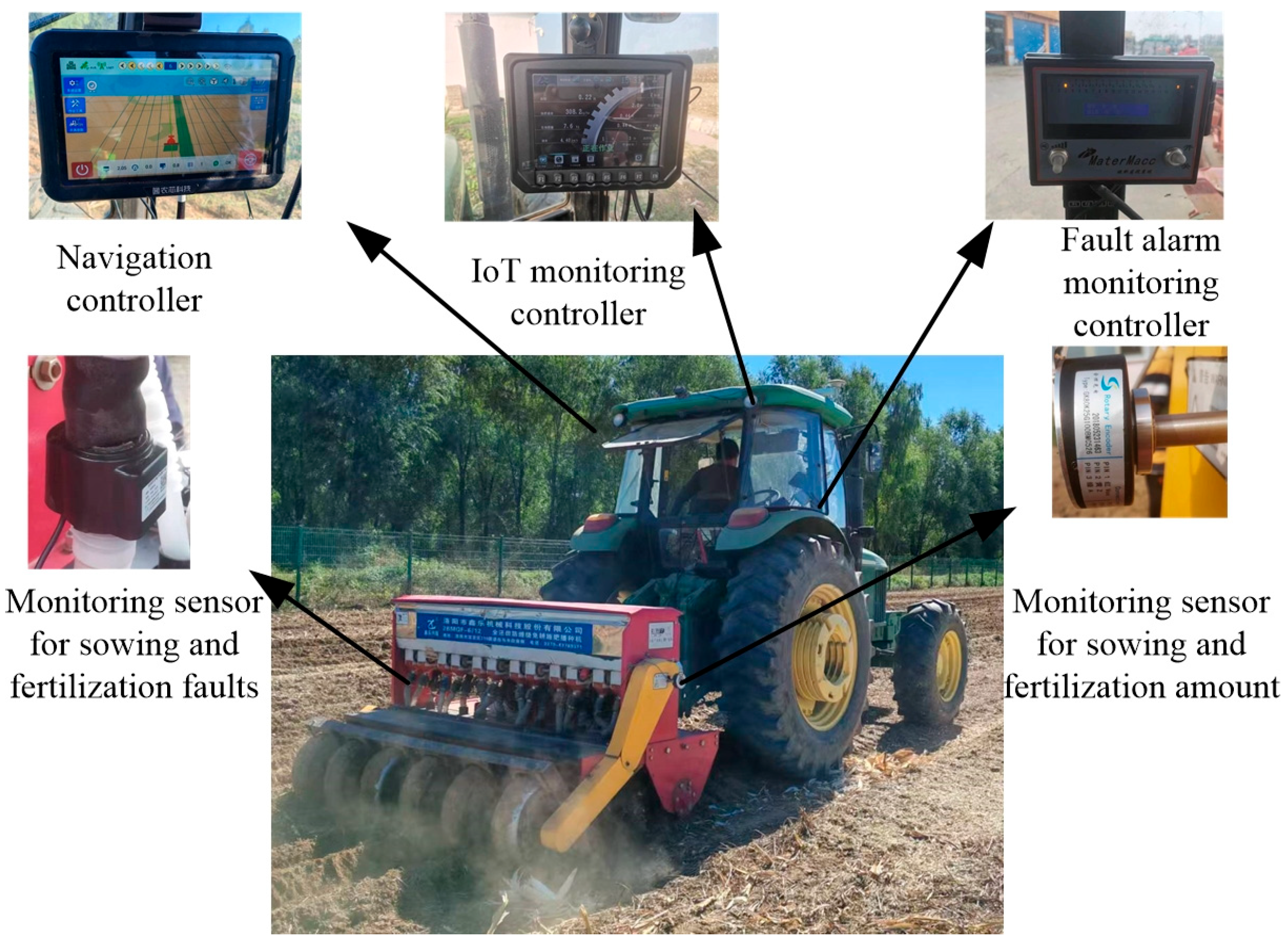
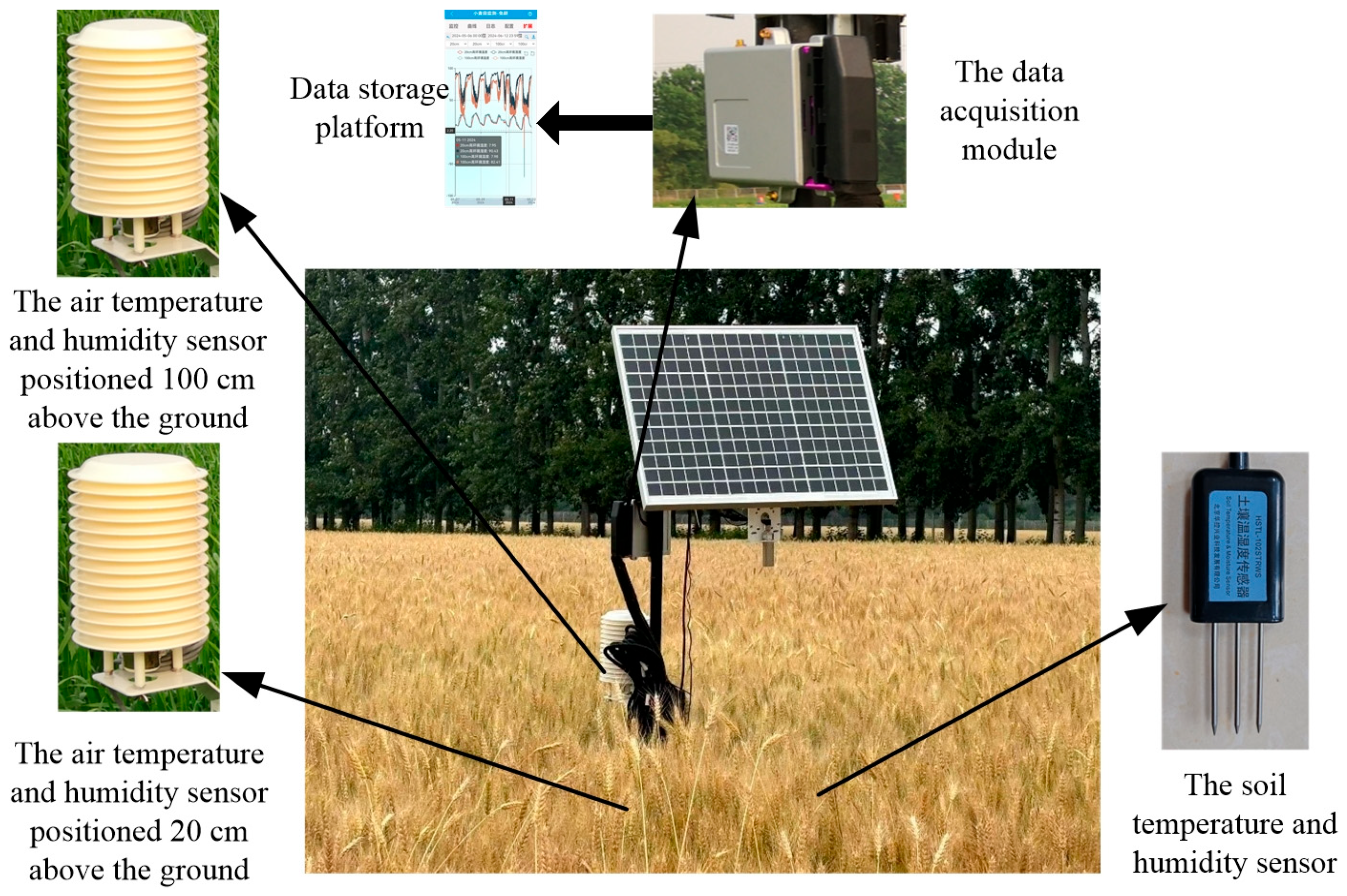
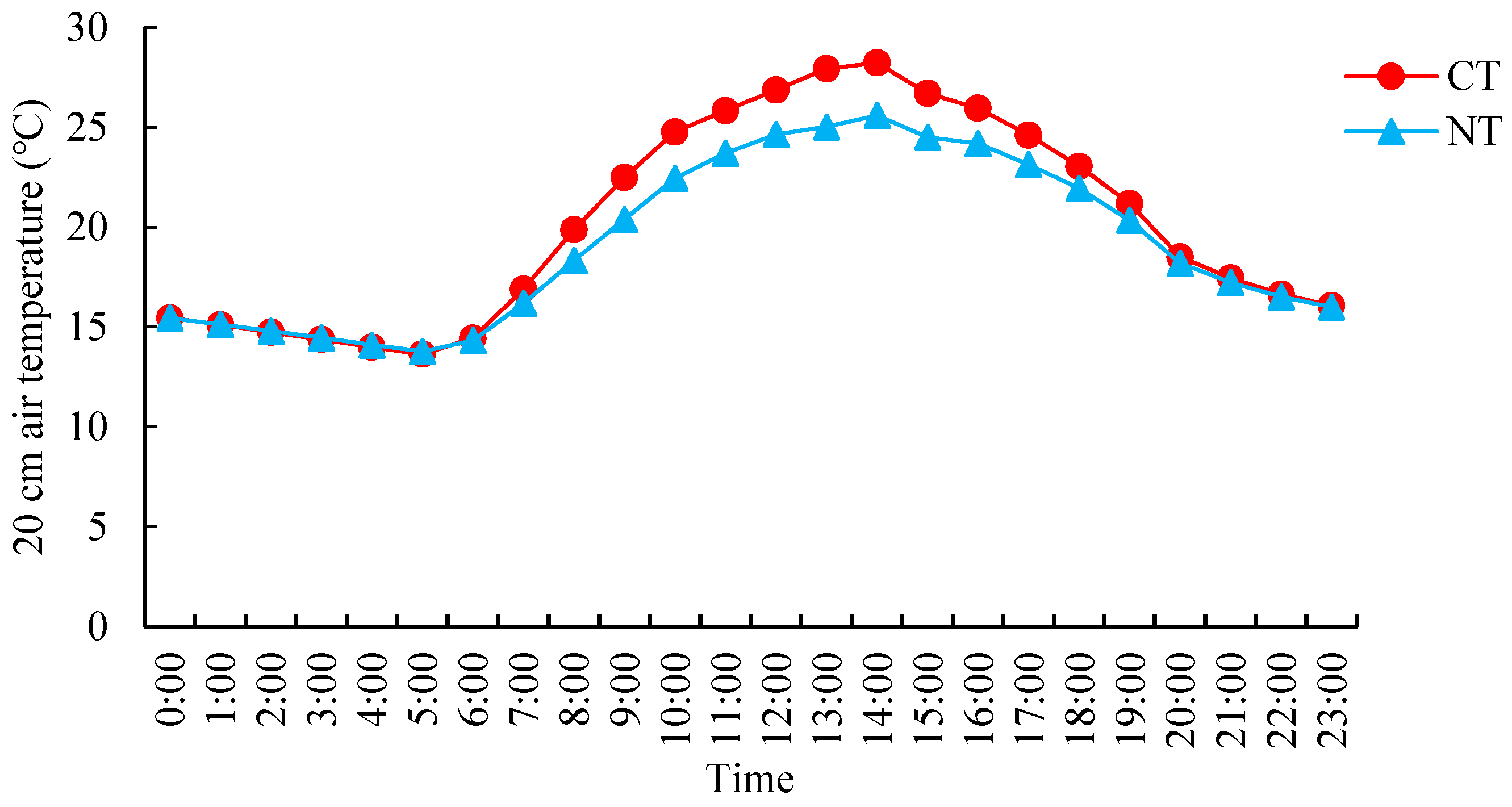
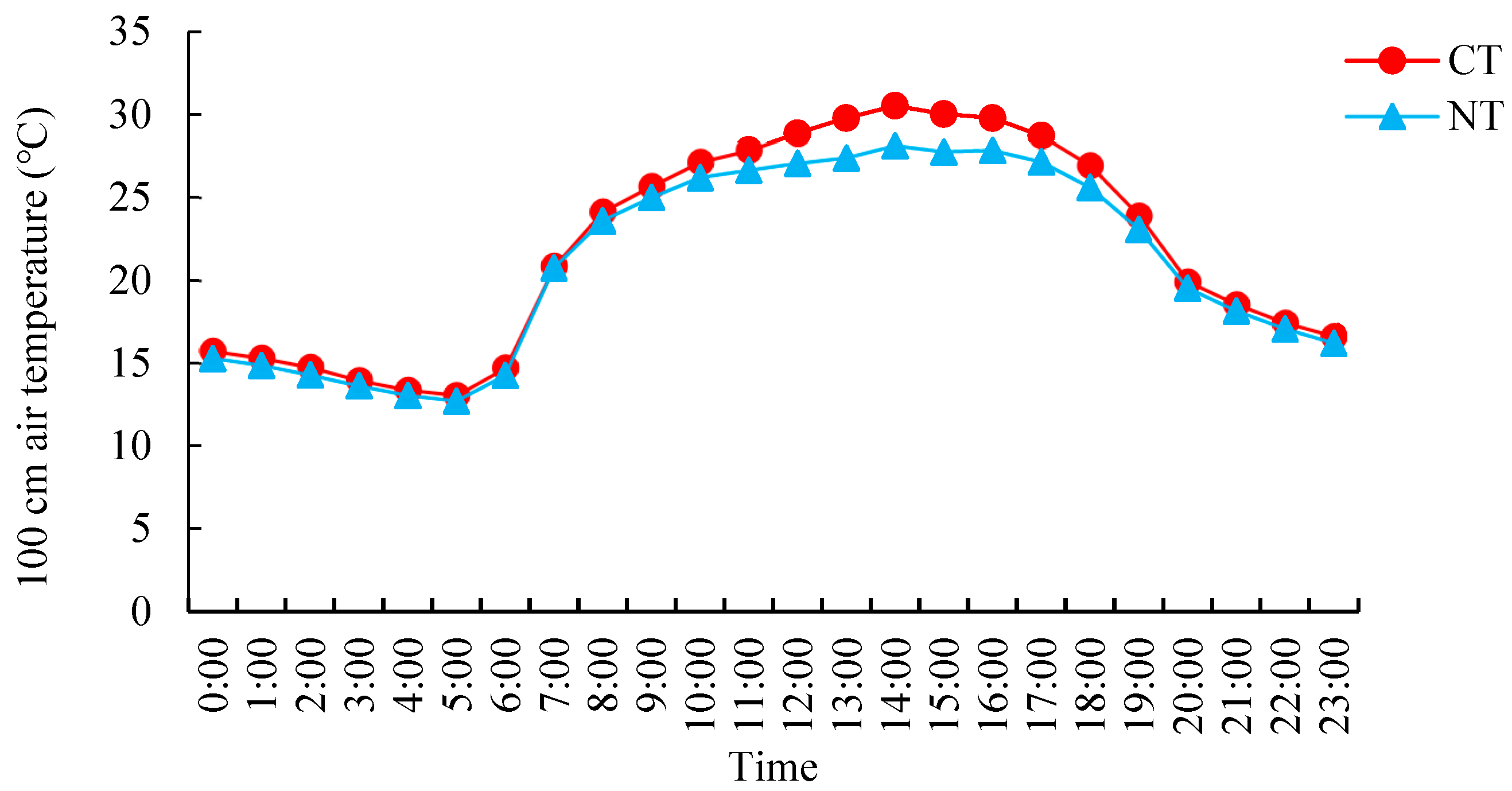
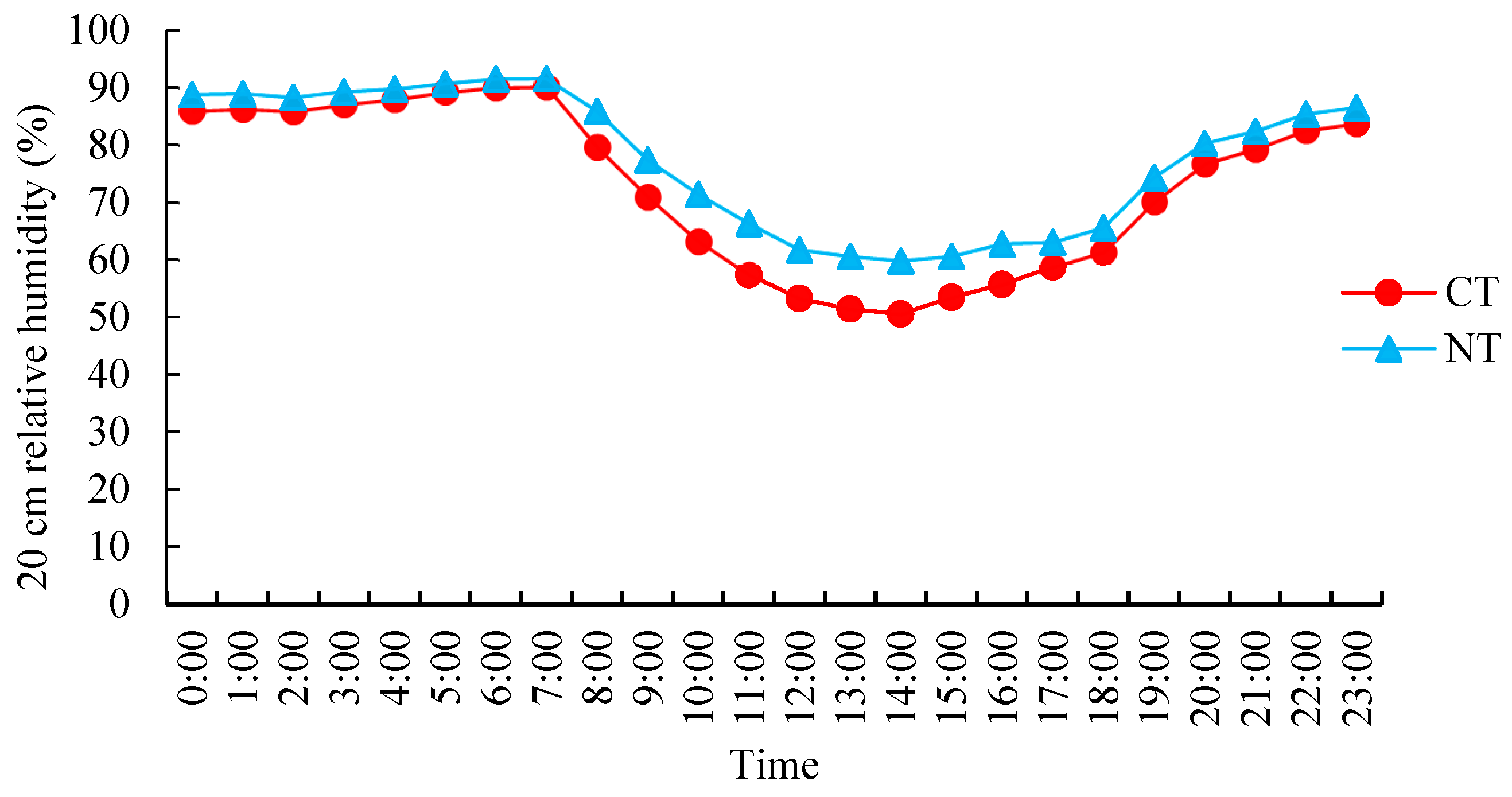

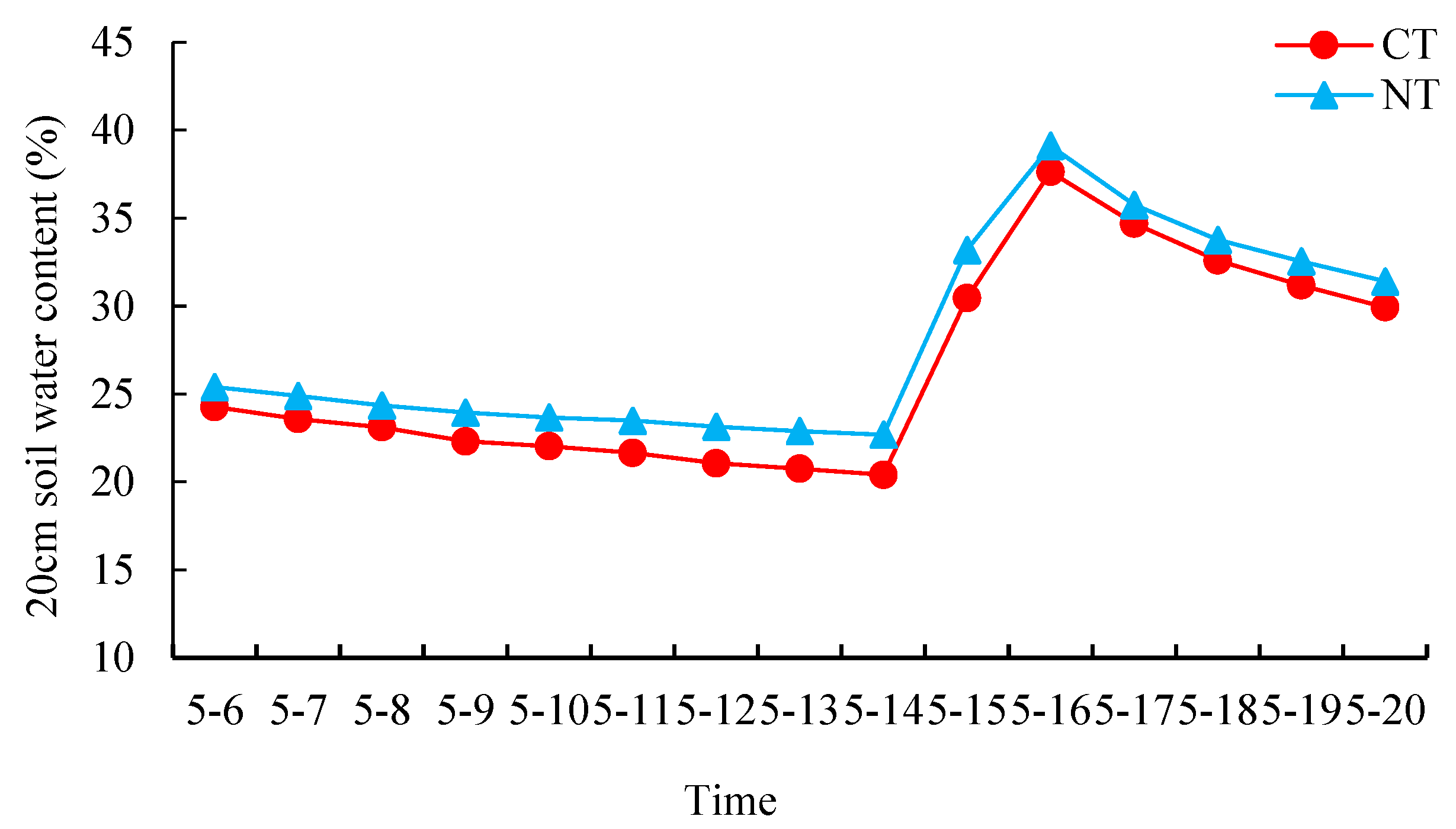
| Treatment | Plant Moisture Content (%) | Dry Weight per Stem (g) | Spike Moisture Content (%) | Dry Weight per Ear (g) |
|---|---|---|---|---|
| NT | 49.35 ± 1.26 A | 2.67 ± 0.04 a | 42.02 ± 0.87 A | 1.64 ± 0.04 a |
| CT | 35.69 ± 0.85 B | 2.49 ± 0.10 b | 30.30 ± 1.03 B | 1.55 ± 0.02 b |
| Treatment | Spikelet Numbers | Numbers of Sterile Spikelet | Spike Numbers (104 ha−1) | Grain Numbers per Spike | Thousand-Grain Weight (g) | Grain Yield (kg ha−1) |
|---|---|---|---|---|---|---|
| NT | 16.33 ± 0.55 a | 2.45 ± 0.10 b | 605 ± 19 b | 29.98 ± 0.60 a | 45.24 ± 0.18 a | 7413 ± 233 a |
| CT | 16.23 ± 0.40 a | 2.68 ± 0.18 a | 678 ± 14 a | 29.08 ± 0.33 a | 41.93 ± 0.44 b | 7218 ± 232 a |
Disclaimer/Publisher’s Note: The statements, opinions and data contained in all publications are solely those of the individual author(s) and contributor(s) and not of MDPI and/or the editor(s). MDPI and/or the editor(s) disclaim responsibility for any injury to people or property resulting from any ideas, methods, instructions or products referred to in the content. |
© 2024 by the authors. Licensee MDPI, Basel, Switzerland. This article is an open access article distributed under the terms and conditions of the Creative Commons Attribution (CC BY) license (https://creativecommons.org/licenses/by/4.0/).
Share and Cite
Dong, Z.; Yang, S.; Li, S.; Fan, P.; Wu, J.; Liu, Y.; Wang, X.; Zhang, J.; Zhai, C. Effects of No-Tillage on Field Microclimate and Yield of Winter Wheat. Agronomy 2024, 14, 3075. https://doi.org/10.3390/agronomy14123075
Dong Z, Yang S, Li S, Fan P, Wu J, Liu Y, Wang X, Zhang J, Zhai C. Effects of No-Tillage on Field Microclimate and Yield of Winter Wheat. Agronomy. 2024; 14(12):3075. https://doi.org/10.3390/agronomy14123075
Chicago/Turabian StyleDong, Zhiqiang, Shuo Yang, Si Li, Pengfei Fan, Jianguo Wu, Yuxin Liu, Xiu Wang, Jingting Zhang, and Changyuan Zhai. 2024. "Effects of No-Tillage on Field Microclimate and Yield of Winter Wheat" Agronomy 14, no. 12: 3075. https://doi.org/10.3390/agronomy14123075
APA StyleDong, Z., Yang, S., Li, S., Fan, P., Wu, J., Liu, Y., Wang, X., Zhang, J., & Zhai, C. (2024). Effects of No-Tillage on Field Microclimate and Yield of Winter Wheat. Agronomy, 14(12), 3075. https://doi.org/10.3390/agronomy14123075








